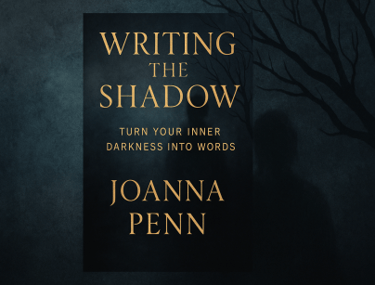Writing the Shadow: A Guide for New Writers
BOOKS REVIEW
Chaifry
7/17/20256 min read


Joanna Penn, a New York Times and USA Today bestselling thriller author under the pen name J.F. Penn and a prolific non-fiction writer for creatives, delivers a transformative guide in Writing the Shadow: Turn Your Inner Darkness Into Words (2023). Known for her Creative Penn podcast and works like The Successful Author Mindset, Penn draws on her studies in theology and Jungian psychology to explore the Shadow—the unconscious, repressed aspects of personality—as a catalyst for authentic storytelling. Launched via a successful Kickstarter campaign in October 2023, this self-help book for writers combines personal vulnerability with practical exercises, reflecting Penn’s journey from a toxic corporate job to a thriving creative career.
Her candid sharing of struggles, such as her divorce, makes this work a beacon for writers seeking to harness their inner complexities.
This review argues that Writing the Shadow is essential reading for new writers, offering a profound framework to transform personal darkness into compelling narratives, alongside actionable tools to build confidence and authenticity. By encouraging writers to confront fears, traumas, and suppressed desires, Penn empowers them to create stories that resonate deeply, as she notes: “All great art taps into darkness, and your most compelling work emerges when you embrace your full humanity” (Penn, 2023, p. 2). For Indian readers, the book aligns with cultural narratives of duality, such as the interplay of light and dark in mythology, and provides a lens to explore personal and societal complexities. Its blend of psychological insight, practical guidance, and inspirational vulnerability makes it an invaluable resource for new writers seeking to craft meaningful stories and navigate their creative journeys.
Writing the Shadow is a non-fiction guide structured in three parts, designed to help new writers explore and integrate their Shadow into their craft. Part 1 introduces the Shadow, rooted in Jung’s psychology, described as “the unconscious part of our personality… the rejected, unacceptable traits and feelings” (Penn, 2023, p. 6). Penn uses Plato’s chariot allegory, stating, “I am the Charioteer, and I am in the race of my life” (Penn, 2023, p. 13), to frame the struggle between light and dark impulses. She offers tools like journaling and personality assessments, emphasizing safety: “You need ways to protect yourself so you don’t get lost in the dark” (Penn, 2023, p. 22). For new writers, she advises, “Start by noticing what you avoid writing about” (Penn, 2023, p. 28).
Part 2 explores the Shadow’s manifestations in life domains—creative wounds, work, money, family, relationships, religion, culture, aging, and death. Penn addresses the creative wound, noting, “The pain that may still be holding you back in your writing life” (Penn, 2023, p. 45), and shares her own: “My first divorce… left scars that shaped my early writing” (Penn, 2023, p. 47). She tackles societal pressures, observing, “Whispers of ‘Who do you think you are?’ and ‘You don’t have permission to write that’ keep us from writing freely” (Penn, 2023, p. 3). On culture, she writes, “The Shadow is different in every culture… shaped by what we’re told is unacceptable” (Penn, 2023, p. 78), and on family, “The stories we tell ourselves about family can lock us in a prison of expectation” (Penn, 2023, p. 82).
Part 3 focuses on transforming the Shadow into creative output through self-acceptance and fearless writing. Penn encourages writers to “let go of self-censorship and fear of judgment” (Penn, 2023, p. 112) to deepen characters and themes. She shares, “Writing my dark thoughts down, they dissolved into the paper, captured between the threads” (Penn, 2023, p. 125), emphasizing writing as therapy. For new writers, she advises, “Your Shadow is a gift—it’s the raw material for stories that connect” (Penn, 2023, p. 130). The book addresses the AI era, urging, “In an age of AI, we need to double down on being human” (Penn, 2023, p. 150). It includes reflective questions and a Companion Workbook, with Penn concluding, “Your Shadow makes your work unique—don’t shy away from it” (Penn, 2023, p. 155). Her personal anecdotes, like overcoming a toxic job, underscore the message: “My darkest days… were the kick in the pants I needed to change my life” (Penn, 2023, p. 53).
Writing the Shadow is a powerful guide for new writers, blending psychological depth with practical tools. Penn’s grounding in Jungian psychology provides intellectual rigor, and her use of Plato’s allegory, where “the dark horse… is the Shadow, pulling against the white horse of my good behavior” (Penn, 2023, p. 13), makes the concept accessible, helping novices understand their inner complexities. The book’s structure—three parts with reflective questions and resources—is beginner-friendly, offering a clear roadmap for exploration.
Penn’s vulnerability, sharing struggles like her divorce, fosters relatability and encourages new writers to confront fears, as she notes, “Writing your Shadow can help you process grief or anger or pain” (Penn, 2023, p. 125). The therapeutic approach, where “the blank page can become a counsellor without you ever having to speak a word aloud” (Penn, 2023, p. 126), is particularly empowering for beginners hesitant to share personal stories. The AI-era relevance, urging writers to “lean into the messy, human parts of your story” (Penn, 2023, p. 151), helps novices differentiate their work from generic content.
For Indian new writers, the book’s exploration of cultural Shadows aligns with mythological dualities, like Shiva’s creative-destructive nature, encouraging authentic storytelling. Penn’s discussion of societal pressures, “the things that family, society, school… deem unacceptable” (Penn, 2023, p. 6), resonates with India’s caste and gender norms, empowering beginners to tackle taboo topics. The reflective questions are practical for crafting layered narratives, inspiring new writers to enrich their characters.
The book’s spare style may disappoint new writers seeking richer anecdotes. Penn’s brief treatment of her divorce lacks depth to fully illustrate Shadow work, potentially leaving beginners unsure how to apply concepts. The first half, focusing on Shadow identification, may feel repetitive for those eager to write, which could frustrate novices seeking immediate writing techniques.
The introspective exercises may overwhelm beginners unfamiliar with psychological self-analysis, particularly in India, where such practices are less common. The focus on individual Shadows under-explores collective issues like caste or colonialism, which could enhance relevance for Indian novices. The reliance on Western frameworks like Jungian psychology may challenge readers unfamiliar with these concepts, and Penn’s British cultural examples may feel distant for Indian beginners, requiring more universal illustrations.
Penn’s divorce anecdote, “My first divorce… left scars that shaped my early writing” (Penn, 2023, p. 47), illustrates how trauma fuels creativity, resonating with Indian writers like Arundhati Roy who weave personal pain into narratives. However, its brevity limits guidance for novices. The reflective questions, encouraging exploration of “the stories we tell ourselves about family” (Penn, 2023, p. 82), are practical but repetitive for beginners eager to write. Penn’s advice to “deepen your author voice with elements of Shadow” (Penn, 2023, p. 112) is empowering for character development, but the lack of detailed narrative examples weakens its impact for new writers.
Why Indian Readers Must Read This Book
Writing the Shadow is profoundly relevant for Indian new writers, offering a framework to explore personal and cultural complexities through storytelling, echoing India’s tradition of embracing duality in mythology, like Kali’s dual nature. Penn’s call to “embrace your full humanity—both light and Shadow” (Penn, 2023, p. 2) empowers beginners to craft authentic narratives addressing caste, gender, or familial expectations, as seen in Bama’s Karukku. Her encouragement to “let go of self-censorship and fear of judgment” (Penn, 2023, p. 112) resonates with Indian writers tackling taboo topics like religious orthodoxy, mirroring Kamla Bhasin’s activism.
The exercises, prompting reflection on “the things that family, society, school… deem unacceptable” (Penn, 2023, p. 6), are ideal for Indian novices navigating societal pressures like arranged marriages or caste discrimination. Penn’s therapeutic approach, where “writing your Shadow can help you process grief or anger or pain” (Penn, 2023, p. 125), aligns with India’s growing mental health awareness, offering beginners a safe space to explore traumas like colonial legacies or social unrest. In the AI era, “doubling down on being human” (Penn, 2023, p. 150) encourages Indian writers to infuse cultural specificity, distinguishing their work globally. This book is a vital tool for Indian new writers to harness their inner darkness, creating stories that resonate universally while rooted in their cultural context.
Writing the Shadow is a transformative guide that empowers new writers to channel their unconscious complexities into authentic storytelling. Its psychological depth, practical exercises, and Penn’s vulnerability make it a standout, despite a spare style and Western-centric frameworks. It offers invaluable tools for creative growth, inspiring beginners to craft resonant narratives. This reviewer recommends it to new writers seeking to deepen their craft and connect with readers profoundly.
